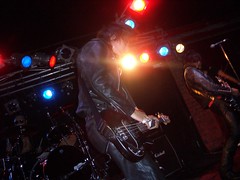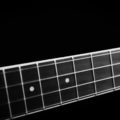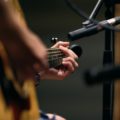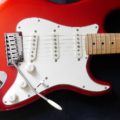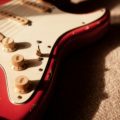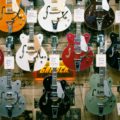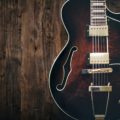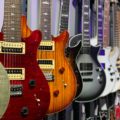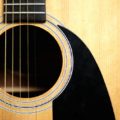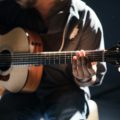The guitar is an incredibly versatile instrument, but it can be challenging to learn new songs due to the six different places on the neck where the same note can be played. This makes traditional sheet music How To Read Piano Piece Music Fast - Learning to play the piano and read sheet music doesn't have to be intimidating. You don't need an exceptionally high IQ for this; all you need is perseverance and consistent practice, along with an easy-to-read piano sheet. By following some guidelines, learning can become easier. Here are some tips to help you as you gradually… less useful for the guitar than for other instruments. Guitar tab is a graphical representation of the guitar neck that shows where each note is to be played, rather than showing the actual notes as in standard musical notation. It can range from simple beginner guitar tab with just the basic components of the song to very complex transcriptions, but the basic concepts are the same throughout. Regardless of your level of musical knowledge, when you learn guitar Mastering the Guitar Fretboard - If you want to learn guitar at an advanced level, it's crucial to memorize the fretboard. This essential task greatly aids in mastering chords and scales. For example, consider a simple chord: C major. It consists of three notes: C (root), E (major 3rd), and G (5th). If you know the fretboard, you can play… tab, you’ll make progress on the instrument more rapidly.
One thing to be aware of is the difference between most of the tab you’ll find online versus the tab you’ll see in books, tablature books, and other printed materials. Online tab is usually constructed with dashes to represent the strings and letters and other symbols to indicate different techniques. Rhythms are usually not as precisely indicated in online tab, and in general, printed tab is more accurate and precise than online tab. Nonetheless, online tab is an invaluable resource that makes it easy to learn guitar with the help of our beginner guitar lessons What's the Most Readily Useful Electric Guitar For Guitar Lessons? - There are several variations, but primarily three types of guitars to consider when starting guitar lessons: Classical Acoustic, Acoustic, and Electric. Many beginners start guitar lessons with a classical acoustic or steel-string guitar. These are the most common types available for borrowing, and it's less likely you'll be loaned a more complex guitar. Learning on… .
Traditional musical notation uses either four or five lines, while guitar tab uses six to represent the six strings. Online, it usually looks like this:
fig 1
E ———————
B ———————
G ———————
D ———————
A ———————
E ———————
The letters to the left show the tuning of each string. This shows standard tuning, where the high E is at the top and the low E is at the bottom. Some tab may leave out the tuning, but you can assume the song is in standard tuning. You may also see tab with a different tuning indicated, like this:
fig 2
D ——————–
B ——————–
G ——————–
D ——————–
G ——————–
D ——————–
This shows an open-G tuning; to follow the tab correctly, you’ll need to tune your guitar 5 guidelines in Mastering the Guitar - Mastering the guitar is undoubtedly one of the most captivating musical instruments we can encounter. If you have recently begun learning to play the guitar or have already mastered a song or two and aspire to become proficient, here are some tips to expedite your learning process and enhance your skills with the guitar. Choose… as indicated.
As stated earlier, notes and chords are indicated in tab by placing numbers to indicate the fret to be played on the appropriate line (string). Open notes are indicated with a ‘0’. So, an E major chord would look like this:
fig 3
E —-0—-
B —-0—-
G —-1—-
D —-2—-
A —-2—-
E —-0—-
This tab shows that you need to fret the A and D strings at the 2nd fret and the G string at the 1st fret, and the rest of the strings should be open. Stacking the numbers over each other indicates that the notes should be played simultaneously, although in this case it doesn’t indicate how long the chord should be held. You’ll also sometimes see chord names listed below the tab, like this:
fig 4
E —-0—-
B —-0—-
G —-1—-
D —-2—-
A —-2—-
E —-0—-
E Maj
Especially online, this practice varies widely, but you’ll generally see it in more professional tablature. As you learn guitar tabs and become more adept, you’ll be able to recognize various chords even without the labels.
In all tab, from beginner guitar tabs to the most insanely complex tabs, single notes are indicated like this:
fig 5
E —————-
B —————-
G —————-
D —————-
A ——–0—2–
E 0—3———-
This tab displays the first four notes of the E pentatonic scale. To play this tab, start by selecting the open low E string, then fret at the third fret and select it again. Move to the A string and select the open string, then fret at the second fret and select it. Note that the actual length of time to play each note, or the rhythm of the notes, is not indicated. Printed tabs, even those designed for novice guitar Learn Novice Guitar - There are only a few ways to learn how to play the novice guitar. Fortunately, there is a new and improved method that allows beginners to learn faster and have more fun in the process. This method involves using specially designed software. Novice Guitar Learning novice guitar involves more than just notes and chords. The… players, are more precise. In a magazine, the same phrase would look like this:
fig 6
-T——————–
-A————|-|——
-B—–|-|—0-2——
——-0-3————-
Notice the line above each note, indicating quarter notes, which means there are four of them per measure. Here are the most common notes you will see in tablature:
(image of the E major scale, starting with whole notes, followed by halves, quarters, eighths, and sixteenths)
Let’s look at these notes. The first note is a whole note, which is worth four beats, meaning you hold the note for four full beats. The next two notes are half notes because they are worth half a measure (in 4/4 time), or two full beats. The following notes are quarter notes, worth (you guessed it) a quarter of the measure, or one beat.
Eighth notes come next, worth half a beat each, with eight in a measure. You count these as ‘1 and 2 and 3 and 4 and.’ The numbers indicate the down beats, and the ‘and’s are the up beats. The phrase ends with sixteenth notes, which are a quarter of a beat each. To count these, divide each beat into four small pieces: ‘1 e and a.’ The ‘e’ and ‘a’ come between the ‘and,’ which was the second half of the beat in the eighth notes. So, sixteenth notes are twice as fast as eighth notes.
This may be confusing at first, but as you continue to learn guitar tabs, you will become more comfortable with this system. It’s also important to use your ear: read the tablature to a song you like while you listen to the song, paying special attention to the note rhythms and how they are notated. And as you learn guitar tab songs, be sure to listen to the song frequently; as you progress, try playing along with the song–it’s a helpful learning experience and a lot of fun as well.
Also, be aware that much of the tab you’ll find online may not have very precise rhythmic notation. For example, if you see this:
fig 7
E -15-12-14-12————————————————–
B —————–15-13-12-13———————————-
G ———————————-14-12-14-12—————–
D ————————————————–15-14-13-12-
A ——————————————————————-
E ——————————————————————-
It can be challenging to determine the exact timing of notes in guitar tab. Although you may assume they are supposed to be sixteenth notes, you cannot be certain. The solution is to listen to the song repeatedly until you can roughly approximate the rhythm and determine the values of each note. This is where published tab has an advantage over online tab, although even rough online tab can make it easy to learn guitar components if you put in some effort.
One of the guitar’s greatest strengths is the expressive capability that you can achieve with the instrument. Techniques such as string bending, hammer-ons, and pull-offs increase the emotional impact of the instrument and provide you with a powerful arsenal of tools. Fortunately, guitar tab has conventions for indicating when these techniques are used. You may not encounter them frequently in beginner guitar tabs, but you will certainly come across them sooner or later, and they are good techniques to practice at the beginning.
String bending involves fretting a given note and then bending the string, causing the pitch to rise to a higher note. For example, you would fret a D note on the G string at the seventh fret:
fig 8
E —————
B —————
G ——7——-
D —————
A —————
E —————
Then, you would bend the note up to E, two frets above the D. This is indicated in tab with a ‘b’ symbol:
fig 9
E —————–
B —————–
G —–7b9——-
D —————–
A —————–
E —————–
Note that this does not mean you should fret the note at the ninth fret; your finger stays on the seventh fret. It’s just the pitch that rises.
Hammer-ons and pull-offs enable you to play legato (smooth, flowing) passages where you don’t pick every note. To execute a hammer-on, fret a note and pick it. Then, without picking again, fret a higher note on the same string with another finger, ‘hammering’ the string with that finger. This may take some time to learn to execute correctly, but it’s an essential skill for every guitarist regardless of musical style. Practice until the second note is the same volume as the first. The tab looks like this:
fig 10
E —————–
B —————–
G —–7h9——-
D —————–
A —————–
E —————–
We’re moving from D to E again, but this time with a hammer-on. You should have your index finger on the seventh fret and use your third finger for the ninth fret. Alternate between your bend and the hammer-on and pay attention to how different they sound. You can also pull off your third finger, pulling down towards the floor slightly to ensure that the D note sounds:
fig 11
E —————–
B —————–
G ——9p7——
D —————–
A —————–
E —————–
Again, try to make the second note sound as loud as the first note. Also, be careful not to hit the surrounding strings as you pull your finger away.
A final technique you will often come across, even in beginner guitar tabs, is tapping. Tapping refers to the practice of fretting a note with a finger (usually the pointer or index finger) of the picking hand. Fret a note with your left hand, pick it, and then hammer down on the same string at a higher fret with your picking hand. This is an advanced technique that may take a lot of time to learn, but you should at least know what the tab looks like:
fig 12
E ——————
B —5–t9———
G ——————
D ——————
A ——————
E ——————
In guitar tablature found online, the act of tapping a note is typically represented by a ‘t’ symbol. However, in tablature found in publications, the tapped note is often enclosed in a circle. It’s not uncommon to encounter tablature that incorporates a series of techniques, such as bends, hammer-ons, pull-offs, and tapping, into a single passage.
For instance, consider the following tab:
fig 13
E ———————————————————————————————
B ———————————————————————————————
G –2-h4-b5-4-2-4-5-4-5-h7-p-5-h7-t9-7-t10-7-t12-7-t14-12-10-12-17-14—
D ———————————————————————————————
A ———————————————————————————————
E ———————————————————————————————
Manuel Marino is a seasoned Senior Producer, Music Composer, and Artist with over a decade of experience. He specializes in branded entertainment across various mediums, including video games, films, and advertising campaigns. With 20+ years as a game music composer, Manuel has worked on numerous platforms, creating diverse orchestral soundtracks. HIRE ME


 Manuel is a passionate, driven, and techsavvy AV technician,
Manuel is a passionate, driven, and techsavvy AV technician, 